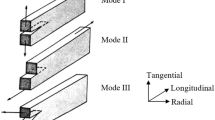Summary
Research was carried out to reduce internal stresses in E. camaldulensis. Altogether, 74 trees of the Circeo National Park were examined; 25 eucalypts were girdled, the cut affecting the entire sapwood, while the remaining trees were taken as controls. They were utilized at different periods after girdling, viz. after 5, 8 and 17 months. The investigations were carried out on butt-logs (up to a height of 3 m) of which diametral boards, 3 m long, were taken, having a thickness proportional to the mean breast height diameter of each tree. The measurements were taken of a total length of 100 in. by a tensodeformometer with an approximation of 0.0001″, determining, together with the length, also the deflection of all the outer strips gradually removed from the board in order to evaluate the strip unit contraction. As concerns board lengthening, the arithmetical difference was determined between the lengths taken before and after the cut. While for unit contractions—expressed by 8 d/l 2—the values are given in in./sq.in., for unit lengthenings the variations are given in inches. The results obtained must be considered as positive: in fact, deformations were reduced, on the average, to 50 percent. These positive results are accompanied by others, of practical nature, all supporting the effectiveness of the method followed. Mention should be made, in fact, that in sawing logs from control trees diverse cracks occurred very often along the pith, separating diametrical boards almost completely, while no fissure was observed on boards from girdled trees.
Zusammenfassung
Es wurden Untersuchungen durchgeführt mit dem Ziel, ein Verfahren zu finden, mit dessen Hilfe sich die “inneren Spannungen” im Stammholz von Eucalyptus camaldulensis vermindern lassen. Insgesamt wurden 74 Stämme aus dem Circeo-National-Park untersucht; 25 Stämme wurden durch “ringeln” abgetötet, wobei der Schnitt das ganze Splintholz durchtrennte, während die restlichen 49 Stämme als Kontrollen dienten. Die weitere Bearbeitung erfolgte in verschiedenen Zeitabständen nach der Ringelung, nämlich nach 5, 8 und 17 Monaten. Die Untersuchungen wurden an 3 m langen Erdstammteilen ausgeführt, aus denen Kernbretter geschnitten wurden, deren Dicke in einem bestimmten Verhältnis zum Brusthöhendurchmesser jedes Stammes gewählt wurde. Die Messungen wurden auf einer Gesamtlänge von 2540 mm mit Hilfe eines Tenso-Deformometers mit einer Ablesegenauigkeit von 0,0001 in. durchgeführt. Hierbei wurde neben der Länge auch die Durchbiegung von Leisten gemessen, die aus den vom Brettrand zum Kern hin fortschreitend aufgetrennten Brettern entstanden. Mit diesen Messungen sollte die spezifische Verformung der Leisten bestimmt werden. Die Längenänderungen wurden als arithmetische Längendifferenz vor und nach dem Schnitt bestimmt und in in. angegeben. Die spezifische Verformung, errechnet aus der Beziehung Δl = (8d)/l 2 wird dagegen in in./sq.in. angegeben. Die Ergebnisse berechtigen dazu, das gewählte Verfahren positiv zu beurteilen. Die Verformungen gingen durchschnittlich um 50% zurück. Ferner verdient die Tatsache Erwähnung, daß beim Auftrennen der Bretter aus den ungeringelten Kontroll-Stämmen häufig Risse entlang der Markröhre auftraten, so daß die Bretter in zwei Teile auseinander fielen. Bei den Brettern aus den geringelten Stämmen waren dagegen keine Risse zu beobachten.
Similar content being viewed by others
References
Boyd, J. D.: Tree Growth Stresses. I. Growth Stresses Evaluation. Aust. J. Sci. Res. Vol. 3 (1950) p. 270/293.
—: Tree Growth Stresses. II. The Development of Shakes and other Visual Failures in Timber. Aust. J. Appl. Sci. Vol. 1 (1959) p. 296/312.
—: Tree Growth Stresses. III. The Origin of Growth Stresses. Aust. J. Sci. Res. Vol. 3 (1950) p. 294/309.
Curro, P., and R. Cividini: Preliminary Observations on Growth Stresses in Eucalypts. 2nd. World Eucalyptus Conf., Sao Paulo. F.A.O. (1961).
Giordano, G., and G. Ghisi: Contribution to the Study of Growth Stresses in Eucalyptus. Sect. 41, IUFRO, Melbourne (1965).
Jacobs, M. R.: The Fibre Tension of Woody Stems with Special Reference to the Genus Eucalyptus. Commw. For. Aust. Bull. No. 29 (1938).
Jacobs, M. R.: Further Studies on Fibre Tension. Commw. For. Bur. Aust. Bull. No. 24 (1939).
Jacobs, M. R.: The Growth Stresses of Woody Stems. Commw. For. Bur. Aust. Bull. No. 28 (1945).
Jacobs, M. R.: Stresses and Strains in Tree Trunks as they Grow in Length and Width. Commw. For. Bur. Aust. Leaflet No. 96 (1965).
Lenz, O., and H. J. Strässler: Contribution à l'étude de l'éclatement des billes de hêtre (Fagus sylvatica L.). Schweiz. Anst. Forstl. Versuchsw. Vol. 35 (1959) p. 369/411.
Author information
Authors and Affiliations
Rights and permissions
About this article
Cite this article
Giordano, G., Curro, P. & Ghisi, G. Contribution to the study of internal stresses in the wood of eucalyptus. Wood Science and Technology 3, 1–13 (1969). https://doi.org/10.1007/BF00349980
Received:
Issue Date:
DOI: https://doi.org/10.1007/BF00349980




